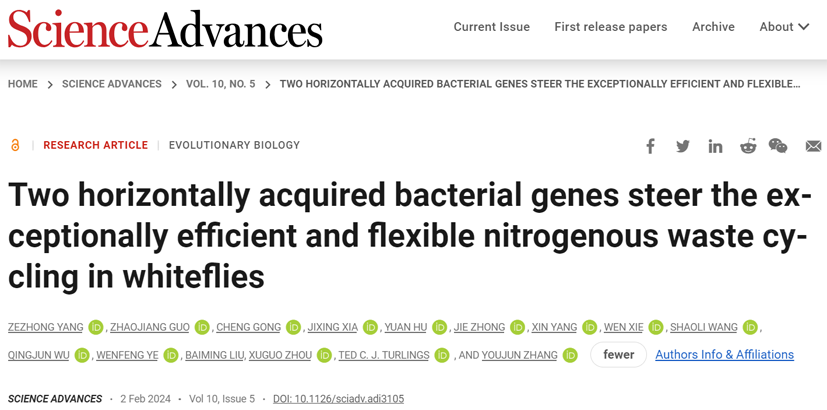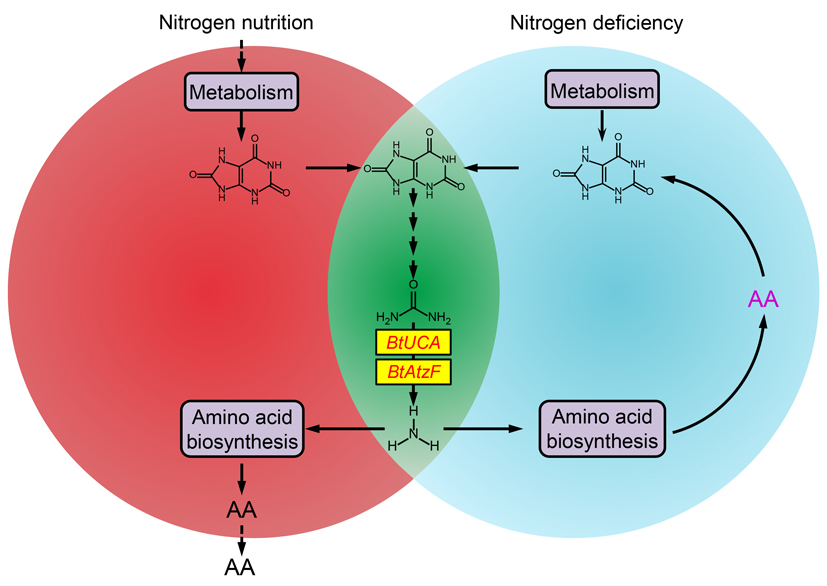Recently, researchers from Institute of Vegetables and Flowers (IVF) of Chinese Academy of Agricultural Sciences (CAAS), in collaboration with Institute of Biology of University of Neuchâtel etc. reported their research results in a paper entitled “Two horizontally acquired bacterial genes steer the exceptionally efficient and flexible nitrogenous waste cycling in whiteflies” published in the journal Science Advances.

Nitrogen metabolism, which provides important nitrogen-containing biological molecules and helps organisms metabolize and excrete toxic nitrogen wastes, served important role for all organisms. Corals, some insects, and sheep even recycle their nitrogen waste via their symbiotic bacteria. Although the nitrogen metabolisms are relatively conserved among animals, several unique nitrogen metabolisms were also reported. Understanding these unique nitrogen metabolisms could shed light on the revealing mechanism of adaptive evolution and species diversity.
The whitefly, Bemisia tabaci (Gennadius), is one the most devastating crop pests worldwide. B. tabaci is extremely polyphagous, and is known to attack more than 600 plant species and shows exceptional host adaptability. As B. tabaci excreting free amino acids as their nitrogen waste, the insects were believed to harbor unique nitrogen metabolism. However, their unique ability to metabolized nitrogen is still poorly understood.
In their newest research, researchers from Zhang's lab showed that the two bacterial genes, which have been captured for long time, are the key builders and important switchers of the whiteflies’ unique nitrogen metabolism. With the two captured genes, the whiteflies synthesize and excrete their unique nitrogen waste. The two captured genes also help whiteflies recycle nitrogen waste when the insect faced with low-nitrogen supplements. Because providing nitrogen nutrition for whiteflies, the two captured genes steer an exceptionally efficient and flexible nitrogen metabolism for whiteflies. The nitrogen metabolism in all enhances the whiteflies’ nutritional adaptation and helps the insects feed on various host plants. Furthermore, researchers also found that the two bacterial genes are not come from the symbiont of whiteflies, but are from their gut bacteria. After capturing the two genes, the bacteria which provided genes for whiteflies were discarded. The evolution scenario is just like the old idioms that “What we lose in hake we shall have in herring”. With the process, the whiteflies eventually evolute their unique nitrogen metabolism which in all increased the insects’ reproduction and invasion.

Figure 1. The two bacterial gene steer unique nitrogen metabolism in whiteflies
The research was supported by the National Key R & D Program of China, the National Natural Science Foundation of China, the Beijing Key Laboratory for Pest Control and Sustainable Cultivation of Vegetables, the Science and Technology Innovation Program of the Chinese Academy of Agricultural Sciences and the European Research Council Advanced Grant.
More information can be found through the link: https://www.science.org/doi/10.1126/sciadv.adi3105
By Zhaojiang Guo (guozhaojiang@caas.cn)